Philip V makes trouble (again)!
21 September, 2016
An old friend, Craig, visited today, over from Brisbane. We played a couple of games of DBA. He was over earlier this year and we played a couple of game then too. One was Syracusans against Pyrrhus. Craig was impressed at how the Syracusan bolt shooter performed (it pretty well won the game from memory, even destroying pike in hand-to hand!).
He was keen to try out a pike army, and likes the Late Spartans (II/31e, who had the option of a bolt shooter to his delight). I went with the Later Macedonians, who are significantly better than the 2.2 list (and pike play differently under 3.0 too).
- Spartans v. Later Macedonians
The Philip V, leading the Macedonians, was the defender and went for ploughed fields and two large gentle hills and a road. It then rained (1 PIP first up).

The Macedonians with cavalry and a Galatian warband on the left and Thureophoroi and Thorakitai on the left.
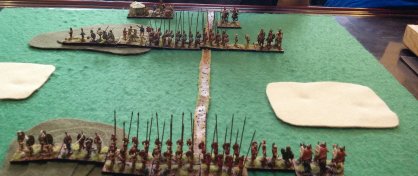
The Spartans, with the artillery next to the Spartan commander and Thureophoroi supporting it. Light Horse are in reserve.
Philip advanced his main body into the gap between the fields. The Spartan stayed stationary and opened up with the bolt shooters. They destroyed the Thorakitai. The next turn Philip was bereft of initiative (1 PIP again). He moved his cavalry up through the muddy field to support the pike. The Spartan bolt shooters fired again and destroyed the Thureophoroi! The Macedonians were not looking in a good space! Fortunately in the next few turns, the leftmost phalanx is only recoiled a few times by the bolt shooters while Philip and his light horse rush to shore up the left wing.
With not enough PIPs to do terribly much, Philip sends in his right wing, and everything goes to plan (there was one?)! The cavalry rout the opposing psiloi, despite being overlapped. The phalanx on the right of the Galatians push back their opposite number, and the Galatians face a phalanx with a double overlap, and destroy it. Suddenly Philip is back in the fight. The Chalkaspides against the Spartan commander are forced to retire; in the circumstances (attacking uphill against the general and overlapped on the left owing to the Leukaspides having been recoiled by the bolt shooters) this was a good result.
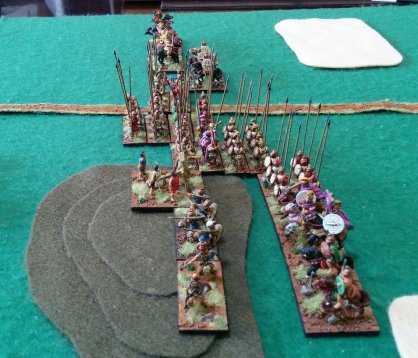
After the initial contact; the psiloi and half a phalanx on the Spartan left wing have vanished. Philip and his light horse have extended their left flank after the loss of their medium foot.
The Spartans made the cavalry pay, destroying it with their light horse and own cavalry. However, the Galatians had their dander up, and they destroyed the rest of the phalanx in front of them. It was now 3-3. The bolt shooter recoils the phalanx opposite them again and the Spartan commander, oblivious to how the battle was developing, forges forward.
Philip is unfazed, or at least his Galatians aren’t. They flank the next phalanx and contribute to its destruction by the Agema. The Spartan commander advances again (were the Chalkaspides skillfully recoiling to take away his overlaps?), and the bolt shooters are demolished by a determined assault by the Leukaspides. Philip and his light horse recoil the foot on the hill opposite them to ensure there were no more upsets in this bloody 6-3 victory.
This was the first outing of the Later Macedonians in a long time. They were not much chop in DBA 2.2. The phalanx could not win in time before the wings folded, but now that pike and blade pursue the dynamics of combat have changed a lot. Also the extra element of cavalry makes for a more interesting army, one I’ll be keen to get out on the board more often.
- Later Macedonians v. Polybian Romans
The success of the Later Macedonians had me wanting to see how they’d perform against Polybian Romans. They were predictably the defender, but had taken an Aitolian ally (II/31j), giving him a 3Kn and an ally block of 4Pk.
The Romans chose to have the wood on their side of the battlefield, hoping to expand out of column in front of it.

The Romans with their cavalry on the left wing and the right wing in column waiting to deploy. The Triarii are deployed to meet the Xystophoroi.
In the opening moves the Romans throw forward a block of velites to delay the Macedonian advance. They are cut to pieces by Macedonian cavalry. The Macedonians reform their line and advance (this was a mistake, as the ally made this cost 4 PIPs, rather than the 2 PIPs available, but we let it pass).
When the Macedonians make contact the Aitolian Xystophoroi destroy the overlapped Triarii they meet. More Triarii plug the gap and resist valiantly, but another block of legionaries is destroyed and the situation is looking hopeless.
Who would have thought Roman cavalry could effect a turnaround? First one element destroys the opposing cavalry, aided by an overlap. The Macedonians falter (low PIPs) and next the Roman commander destroys the isolated Illyrian cavalry in a one on one, while the other cavalry, flushed with their initial success, tackle Philip, aided by velites flanking him, and win! Amazingly out of nowhere the Macedonian cavalry are routed and the disaster in the centre is averted.
Despite the loss the Macedonians acquitted themselves very well with the new list and the new rules. They are now an interesting army. Craig enjoyed both games, both which had surprising reversals of initial success. He’s keen to get his own army for DBA soon.
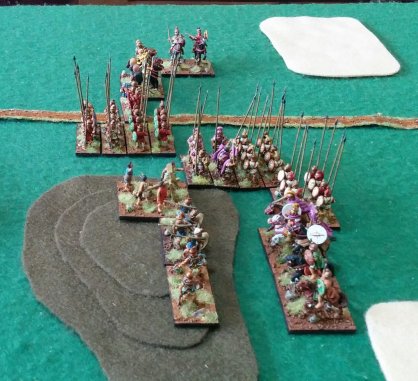
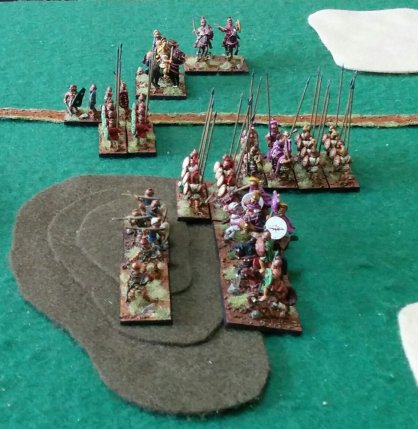
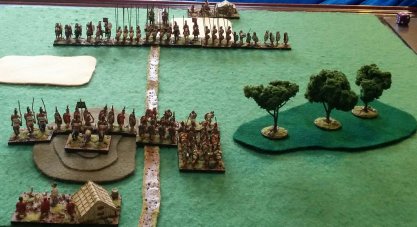

21 September, 2016 at 11:31 pm
Great reports Mark. I’ve not looked at Later Macedonians under 3.0. The ally was also an interesting choice.
22 September, 2016 at 7:43 am
Thanks. The ally is problematic, as it is likely to involve extra PIPs. The elements are in the middle of the line; the least disruptive ally is on a flank.
22 September, 2016 at 6:25 pm
I think the 3Kn is an interesting addition. That said you have to consider carefully the benefits of an ally with the PIP costs. It’s another fascinating additional layer with DBA 3.0.
22 September, 2016 at 6:27 pm
It is. The 4Wb isn’t bad in that role, as the first battle showed!
22 September, 2016 at 6:32 pm
I was surprised you selected a single Wb. I pondered this with Early Carthaginians and the low factor seems too low to break an infantry line. But you managed it.
22 September, 2016 at 7:07 pm
Yes, the Later Macedonian list is not the most exciting, and one 4Wb is the limit. It does mean that you really need it to be flanked by pike to give it a double overlap.
22 September, 2016 at 7:12 pm
But the extra mounted is useful and there is a school of thought that cavalry are more useful than 3Kns, as they survive. Of course the advantage of standard DBA is you can build all these armies and try them out!
22 September, 2016 at 7:13 pm
That’s true; it’s an improvement on the old list, but the alternatives for the 4Wb are a Ps or a 4Ax.